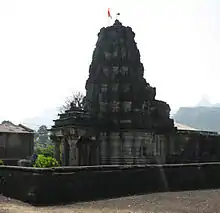Hemadpanti architecture
Hemadpanti Sculpture (also spelled as Hemadpanthi) is an architectural style, named after its founder, the prime minister Hemadpant (1259-1274 CE) of the court of Seuna Yadavas of Devagiri.


Architectural elements
The Hemadpanti architecture is a notable architectural style that emphasizes the importance of Center of mass in the construction of every element. Unlike other architectural styles, in Hemadpanti architecture, no element is glued together using adhesives such as Chuna or Cement. Instead, each element is precisely placed and balanced to maintain structural integrity without the need for adhesives. This technique highlights the mastery of ancient Indian architects who possessed a deep understanding of the principles of physics and engineering. This building style was formed during the 13th Century in Maharashtra, and incorporated black stone and limestone, which were readily available.
Notable examples
- Khandoba Mandir, Beed.
- Gondeshwar temple, Sinnar[1]
- Hembadpanti Mahadev Mandir Sakegaon, Sakegaon, Chikhali, Buldhana[2]
- Markanda Mahadev, Chamorshi
- Tulja Bhavani
- Bhagwant Temple, Barshi
- Aundha Nagnath Temple
- Vitthal Temple, Pandharpur - but little early work remains. There is also a small temple of Shri. Vitthal, which is as old as the main Vitthal Mandir, in Isbavi area of Pandharpur known as Wakhari Va Korti Devalayas and also known as Visava mandir.
- Palasnath Mandir, Indapur, Pune, now partially submerged in back waters
- Bhimashankar Mandir
- Nagra Temple, Gondia
- Yamai Mandir, Mahalung, near Akluj
- Narsimha Mandir, Partur, near Aurangabad
- Shri Mallikarjun Mandir, Achaler
- Mankeshwar temple, Zodage, Tal. Malegaon, Dist. Nashik, Maharashtra, India.
- Mahadev Mandir, Lohara, Yavatmal
- Bhimashankar Mandir ,Taka [Latur]
References
- "Gondeshwar Temple". Maharashtra Bhraman. 2013-08-14. Retrieved 2022-05-14.
- "Hemadpanti Mahadev Mandir Sakegaon". www.onefivenine.com. Retrieved 2022-05-14.